Yoho National Park may be small in comparison to its next-door neighbour, Banff National Park, but don’t let that dissuade you from visiting. In winter, Yoho National Park is a complete delight – a veritable winter wonderland and one of Canada’s most stunning parks, packed with mountains, glaciers, waterfalls, alpine lakes, and snowy meadows.
In winter, there is plenty to do. Book a stay at Emerald Lake Lodge or nearby in Field and explore the area trails on snowshoes or cross-country skis.
Snowshoe or hike to gorgeous Wapta Falls. Ski to Ross Lake or Sherbrooke Lake. And don’t miss a visit on cross-country skis to Lake O’Hara, where you’ll find a premier backcountry lodge and the Elizabeth Parker Hut.
This post includes some affiliate links. If you make a qualifying purchase through one of these links, I will receive a small percentage of the sale at no extra cost to you. Thank you very much for your support.
Useful information for your trip to Yoho National Park in winter
Permits: Before you visit Yoho National Park in winter, be sure to purchase a national park pass. The Discovery Pass is the most cost-effective way to visit the park. Its good for a year and it allows unlimited admission to over 80 other national parks or national historic sites.
Cell coverage: Don’t count on a cell signal.
Maps: The best map for the trails in the park isGem Trek Lake Louise and Yoho. For an offline hiking app I recommend Organic Maps.
Winter gear: Pack cross-country skis, snowshoes, microspikes, and hiking poles so you can take advantage of all the activities in Yoho National Park. You can rent snowshoes and skis at Emerald Lake Lodge. You could also pick up rental gear in Lake Louise at Wilson Mountain Sports. They also sell winter clothing and gear.
Winter clothing: Take all the winter clothing you think you’ll need as the closest place to get any is Lake Louise.
Winter driving safety tips: Pack an emergency kit and I recommend you read How to Survive a Winter Drive: 15 Tips for Safety.
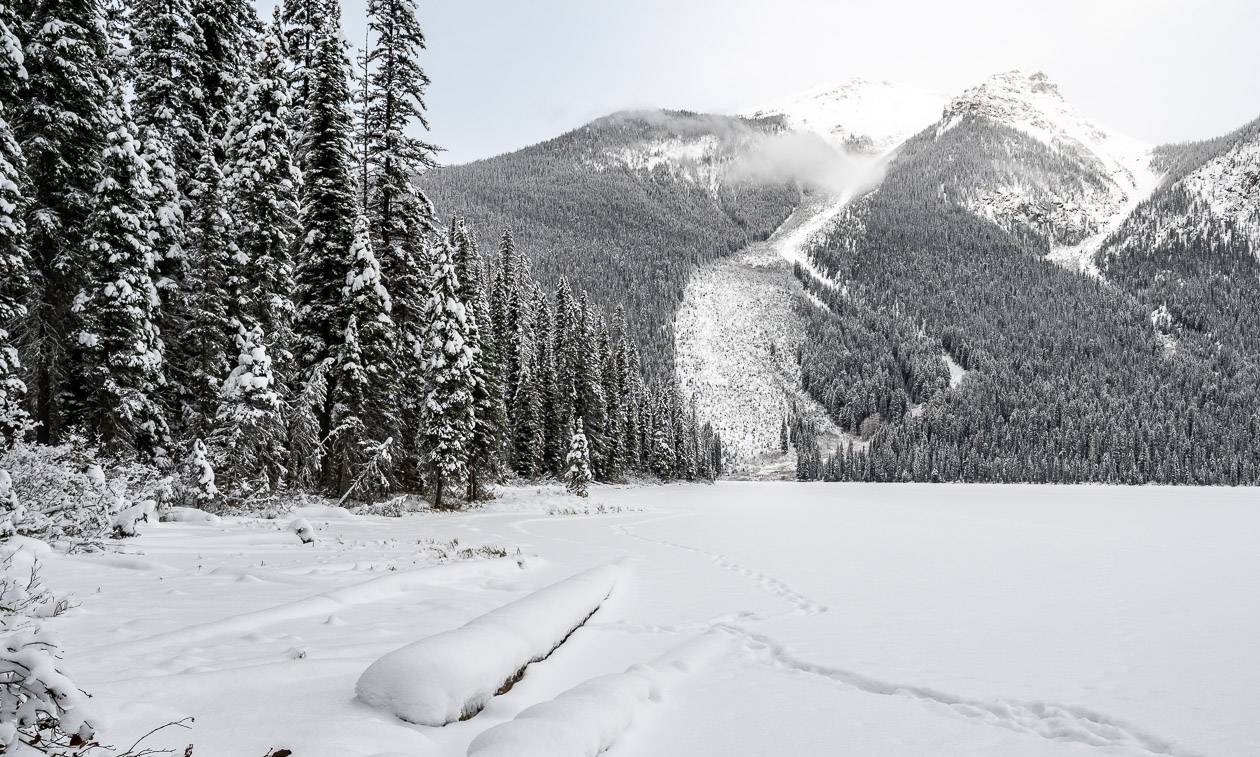
How to get to Yoho National Park
The best way to get to Yoho National Park in winter is to drive. Even if you could get there via a bus to Lake Louise and a taxi to Emerald Lake Lodge, you would be limited in where you could go. If you rent a car, be sure to get snow tires as the Trans-Canada Highway isn’t always a fun road to drive.
It’s 225 km from the Calgary Airport to Field in Yoho National Park. Lake Louise is just a 27 km, 20-minute drive to the east. Golden to the west is 57 km and about a 45-minute drive away.
Beware of the upgrades happening to the Trans-Canada Highway as the highway is regularly shut down to and from Golden. Check for planned closings beforehand so you don’t get stuck driving the long route through Kootenay National Park.
Map of things to do in Yoho National Park in winter
- Click on the three dots in the top right hand corner to email a copy of the map.
Winter conditions in Yoho National Park
Yoho National Park in winter can be a snowy, cold place but it can also be warm with lots of sunshine. You literally have to plan for every possibility as weather changes quickly in the mountains.
I highly recommend you check the weather forecast before heading out. I have had many a white knuckle drive through Yoho National Park in winter – and prefer to cancel now if I know the driving and visibility is going to be atrocious.
Other tips that are especially important in Yoho National Park in winter
Be smart: Let someone know where you’re planning to go and when you’re expected to be back.
Trail conditions: Before you head out on any trails in Yoho National Park in the winter, check trail reports. Some trails are best avoided as they cross avalanche paths. It’s up to you to stay safe outdoors.
Avalanche reports: Check to see what Avalanche Canada has to say about risk in the backcountry. Unless you have expertise and the right gear, avoid avalanche country altogether.
Be prepared: Pack the hiking essentials, and in winter I’d also suggest you pack extra socks, a warm down jacket, hot drinks, and lots of high energy food. Follow the guidelines for staying safe on outdoor adventures suggested by Adventure Smart.

Hikes and snowshoe outings in Yoho National Park in winter
Snowshoe or hike the Emerald Lake Loop
The 5.3-km Emerald Lake Loop is an easy snowshoe or winter hike that can be done in either direction. It’s perfect for families (you could pull the wee ones on a sled if necessary) or those who don’t get out very often. The Emerald Lake loop gets a lot of traffic, so it doesn’t take long for the trail to get packed down. There’s some grand mountain scenery to enjoy as you make your way around the lake.
It’s important to know that there is one avalanche chute that comes right down to the Emerald Lake trail. It’s bookended with warnings, so it’s hard to miss. Stay away from the chute if the avalanche danger is high – particularly after a heavy snowfall. Either head out to the middle of the lake, providing it’s frozen or come back another time to do it.
Note: Check in with the rental shop at Emerald Lake Lodge for current conditions before you head out across the lake.





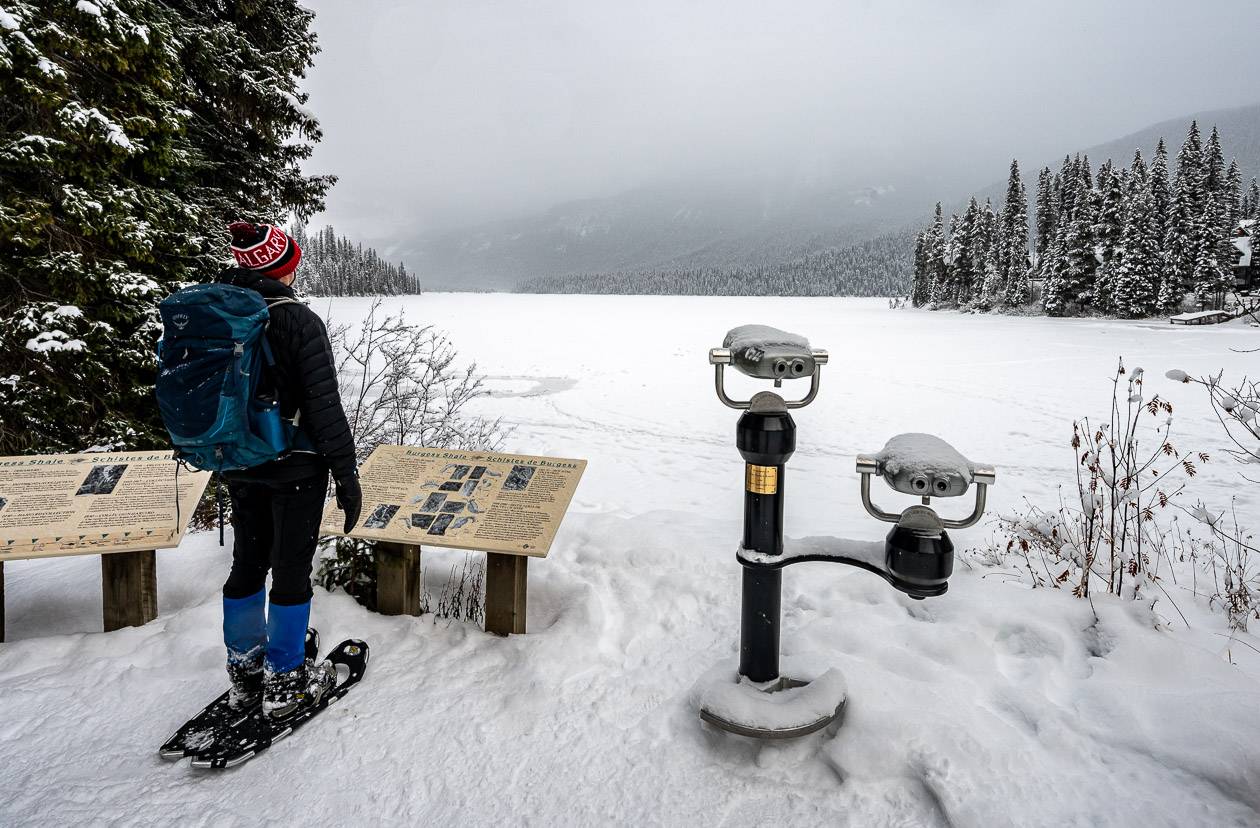
Emerald Alluvial Fan Loop
After a large snowfall, John and I were the first out breaking trail on the 4.3 km Emerald Alluvial Fan. It takes off from the Emerald Lake Loop from the far end of Emerald Lake near the bridge. The Alluvial Fan trail makes a loop, offering some seriously good mountain views along the way.
You can also cross-country ski the loop. In the past it’s been track set, but even if it wasn’t, it would be fun to do it, providing the snow isn’t too deep. Under the right conditions you could access it by skiing down the length of Emerald Lake.


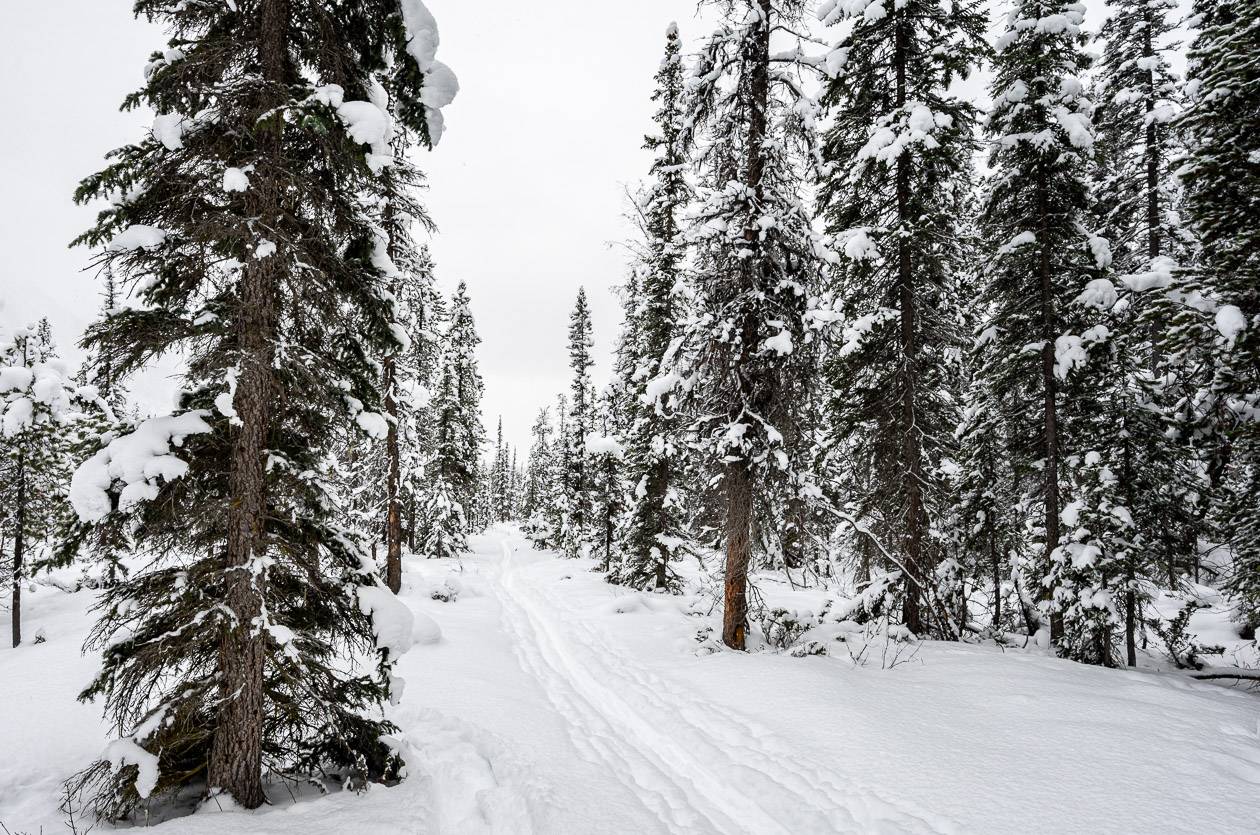
Hamilton Falls
From the south end of the main parking lot at Emerald Lake, look for the trail signed to Hamilton Falls and Hamilton Lake. It’s a short hike – only 0.8 km one way to the base of the falls – but it’s surprisingly steep. It says just 30 metres of elevation gain, but it felt like more than that.
Do it with snowshoes after a fresh dump of snow. Otherwise, hiking boots and perhaps a pair of microspikes will do the trick.
It’s a quick outing that you can knock off in 30 – 45 minutes, but it’s certainly worthwhile.
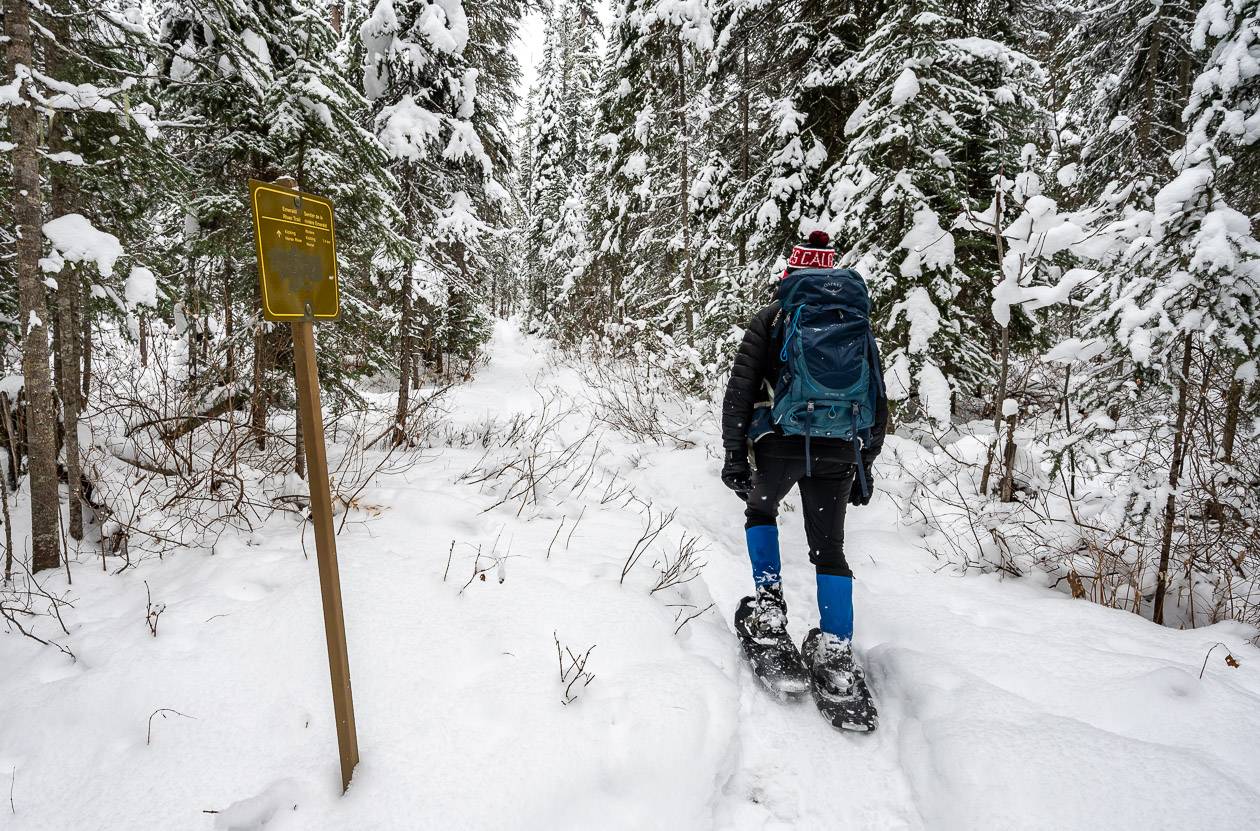

Wapta Falls
Wapta Falls, one of the largest waterfalls in the Canadian Rockies by volume, is a study in blue-green ice in winter.
The hike or snowshoe to Wapta Falls is a must do winter activity if you’re in Yoho National Park in winter – but bring your own snowshoes if there’s fresh snow as there is nowhere nearby to rent. The falls themselves are awe-inspiring, especially on a bluebird day when the snow sparkles like diamonds.
To access Wapta Falls in winter, park in a small lot by the Trans-Canada Highway and then hike or snowshoe in 4.4 km.
There isn’t a lot of elevation gain – perhaps 30 metres. In total, plan on 3 – 3.5 hours for the return trip. There are some people that cross-country ski to the falls but the final downhill section is too tight to turn, so take your skis off and walk down. It’s slower in winter to hike because the trail is several kilometres longer than the summer trail.
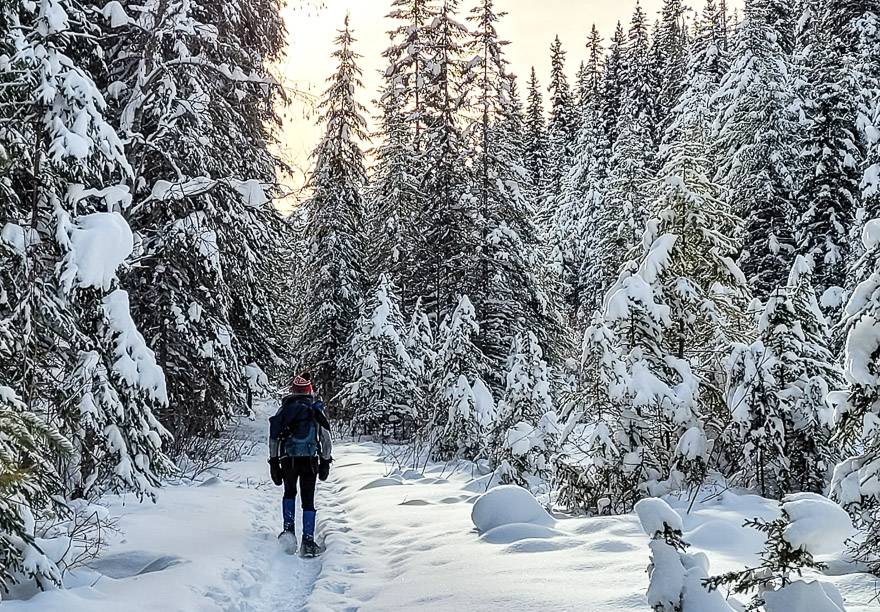
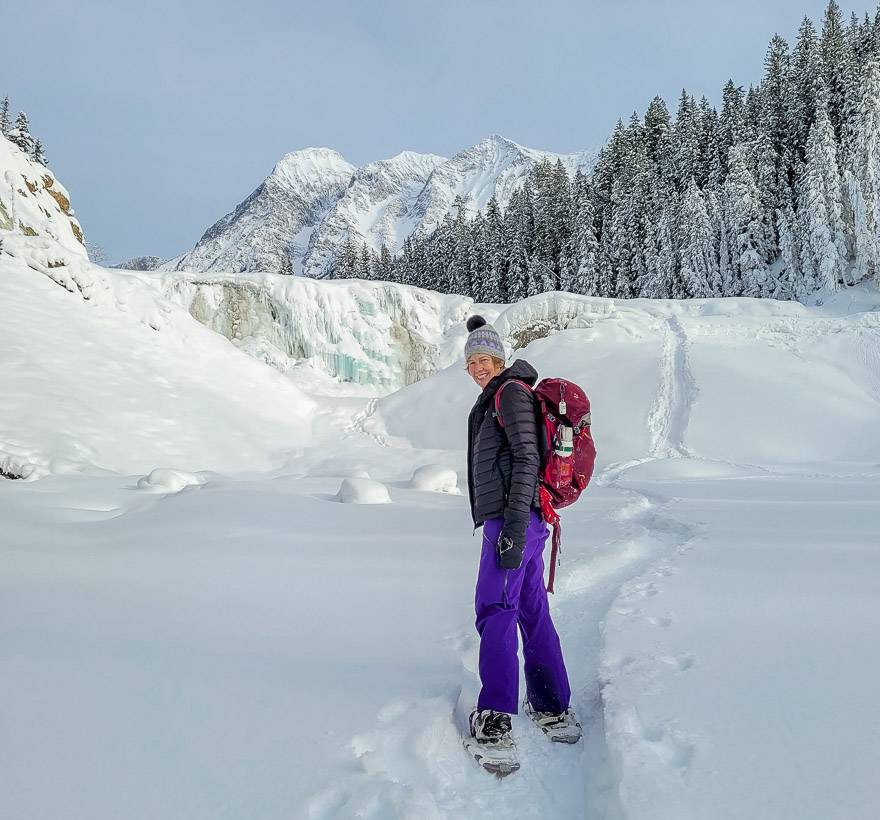
Sights to see in Yoho National Park in winter
Visit the Natural Bridge
The Natural Bridge is easy to find. Drive 2.4 km up the road towards Emerald Lake Lodge from the Trans-Canada Highway, and you’ll find the parking lot on your left.
When I have visited the Natural Bridge in Yoho National Park in winter, it has never been sunny, so all I’ve seen is a lot of white on white. Close-up photos of frozen water under the natural bridge are sometimes seen on Instagram, but you’ll have to make the call if its worth risking it. I think not unless there has been a massive cold spell.



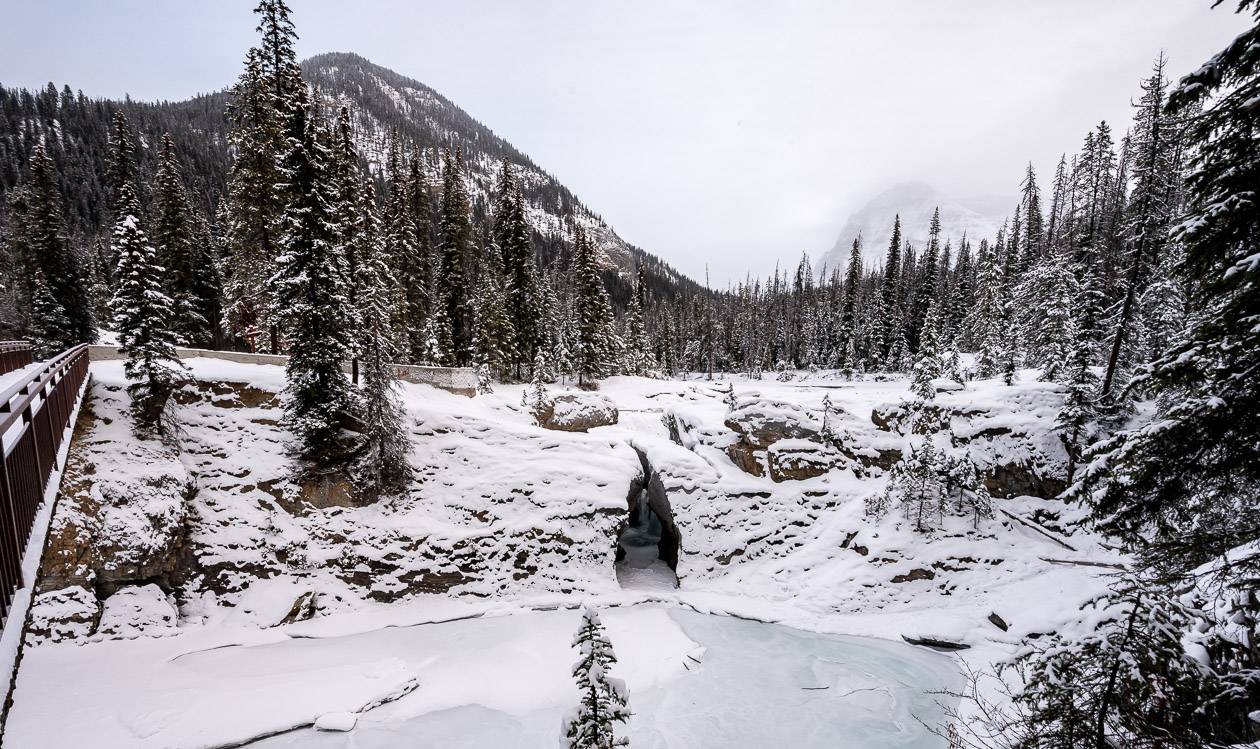
Cross country-skiing in Yoho National Park in winter
Kicking Horse Trail
Pick up the Kicking Horse trail at the north side of the Natural Bridge parking lot. Ski down a wide fire road for about 2.3 km to a bridge over the Emerald River. In another 100 m cross another bridge over the Amiskwi River. Shortly after the bridge there is an intersection. The right-hand trail is the long Amiskwi River Trail that travels for 35 km to Amiskwi Pass.
Instead stay left and ski through pretty sections of forest to an open area with good views. You’ll also see the Kicking Horse River here. You can continue skiing for a couple more kilometres to reach the intersection with the Otterhead Trail. Stay left and continue for 0.5 km to reach the end of the trail at Otterhead River.
It’s a 6.5 km ski back to the parking lot but the total elevation gain is just 60 m. The Kicking Horse Ski Club looks after the trails in the area. All donations are welcome.
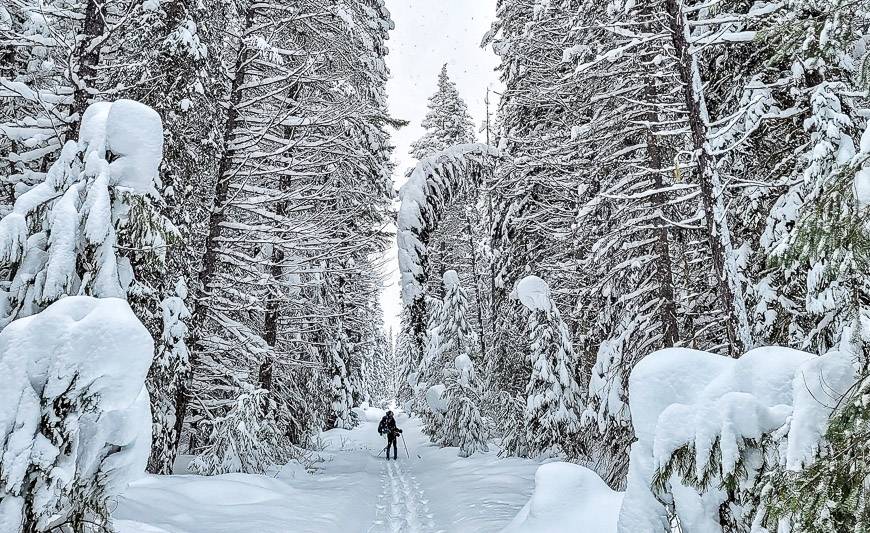

Lake O’Hara area (can be done on snowshoes too)
The Lake O’Hara area on a bluebird day is one of the prettiest places in Canada to explore. But to visit, you will need to cross-country ski or snowshoe 11 km one-way (with an elevation gain of 440 m) along the Lake O’Hara Fire Road.
Some skiers do that as a day trip – and it’s very doable, but it’s not for everyone. Lake O’Hara Lodge used to offer lunch when they were open in winter, but I’m not sure if that’s an option now. Pack some food and a hot drink in case it’s not.
If you’re after an overnight experience in the Lake O’Hara area there are two options.
Try to nab a stay at the ever popular Elizabeth Parker Hut. You can check availability and book online. In winter the hut sleeps 20 people but you’ll need to bring a sleeping bag and be cool with sleeping in shared rooms. There is a kitchen with most of the utensils and dishes you’ll need too.
The other option is to book a stay at beautiful Lake O’Hara Lodge. It’s a far pricier alternative but a real treat as the food is fantastic and a guide is provided to take you cross-country skiing.
That’s a good thing as much of the terrain around Lake O’Hara is in avalanche country.
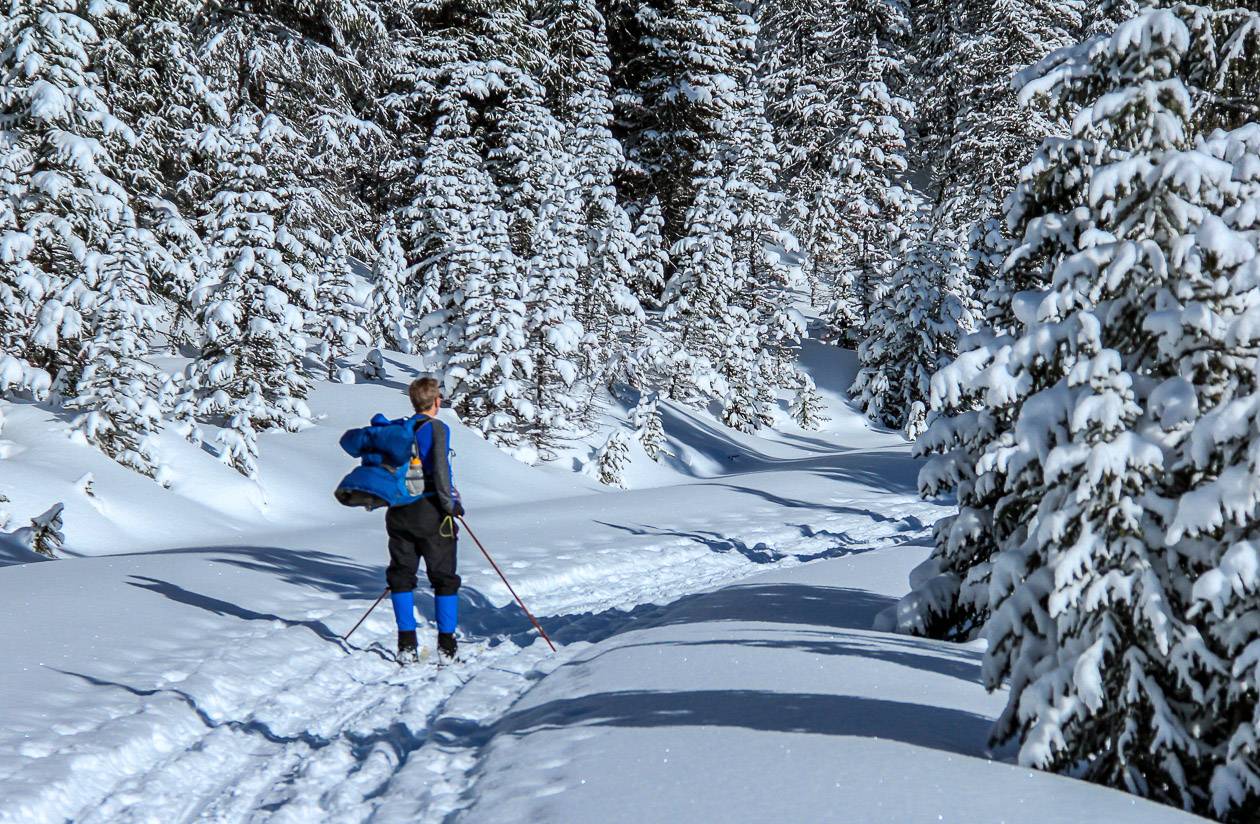
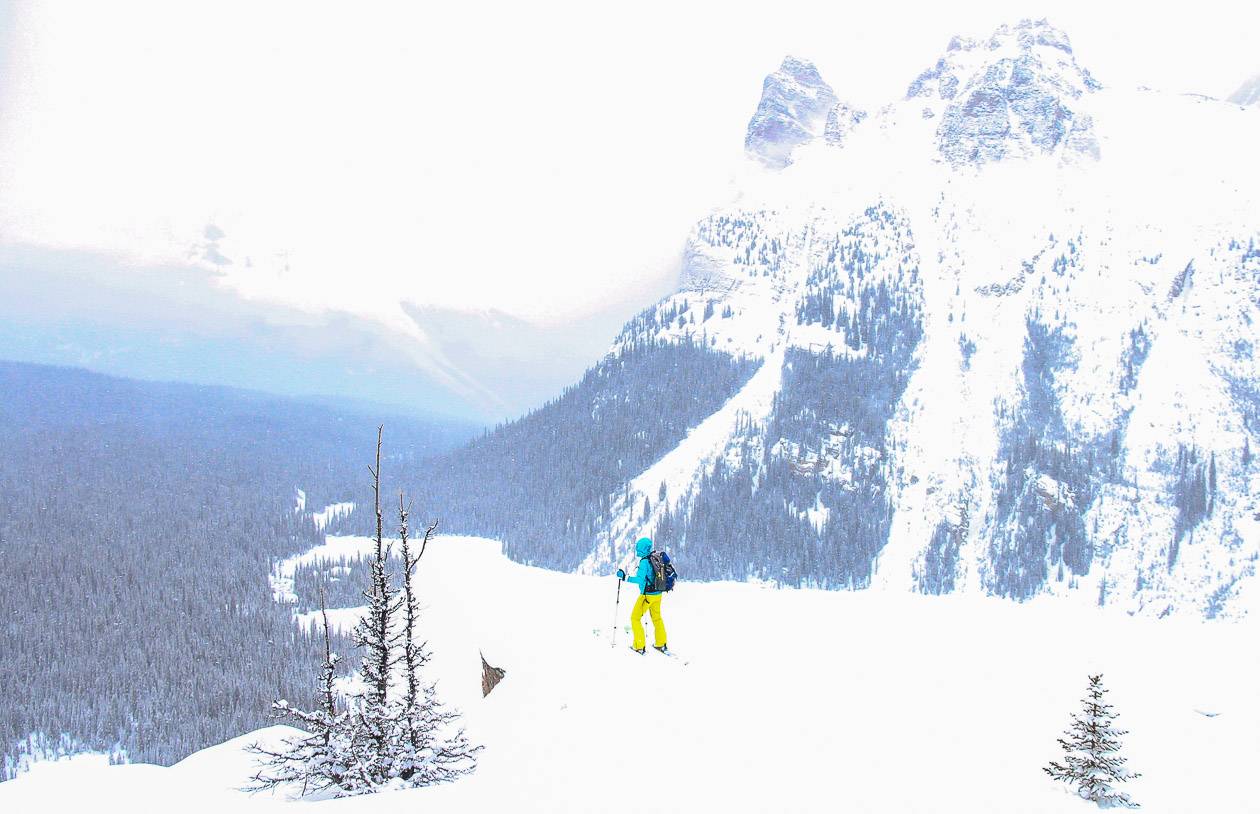
Ross Lake
The cross-country ski to Ross Lake starts from the parking lot used to access the Lake O’Hara Fire Road . There is also a place to park by old Highway 1A, shortly after you cross the train tracks. (There is signage on the Trans-Canada Highway directing you to Lake O’Hara, about 14 km west of Lake Louise or 14 km east of Field).
John and I started cross-country skiing on what is now called the Great Divide trail but was once Highway 1A. The trail climbs gradually for 2 km to reach a signed turn-off for Ross Lake.
Turn right and climb gradually for 1.3 km to reach Ross Lake. Continue on the trail for another 3 km to reach the Lake O’Hara Fire Road. This section of trail is challenging. It’s true backcountry skiing – cue the five downed trees and deep, untracked snow.
Turn right when you reach the Lake O’Hara Fire Road and ski it for 2 fast kilometres back to the parking lot. It’s a 5-miute walk if you parked by old Highway 1A. All told it’s a 9 km loop with an elevation gain of 200 m.
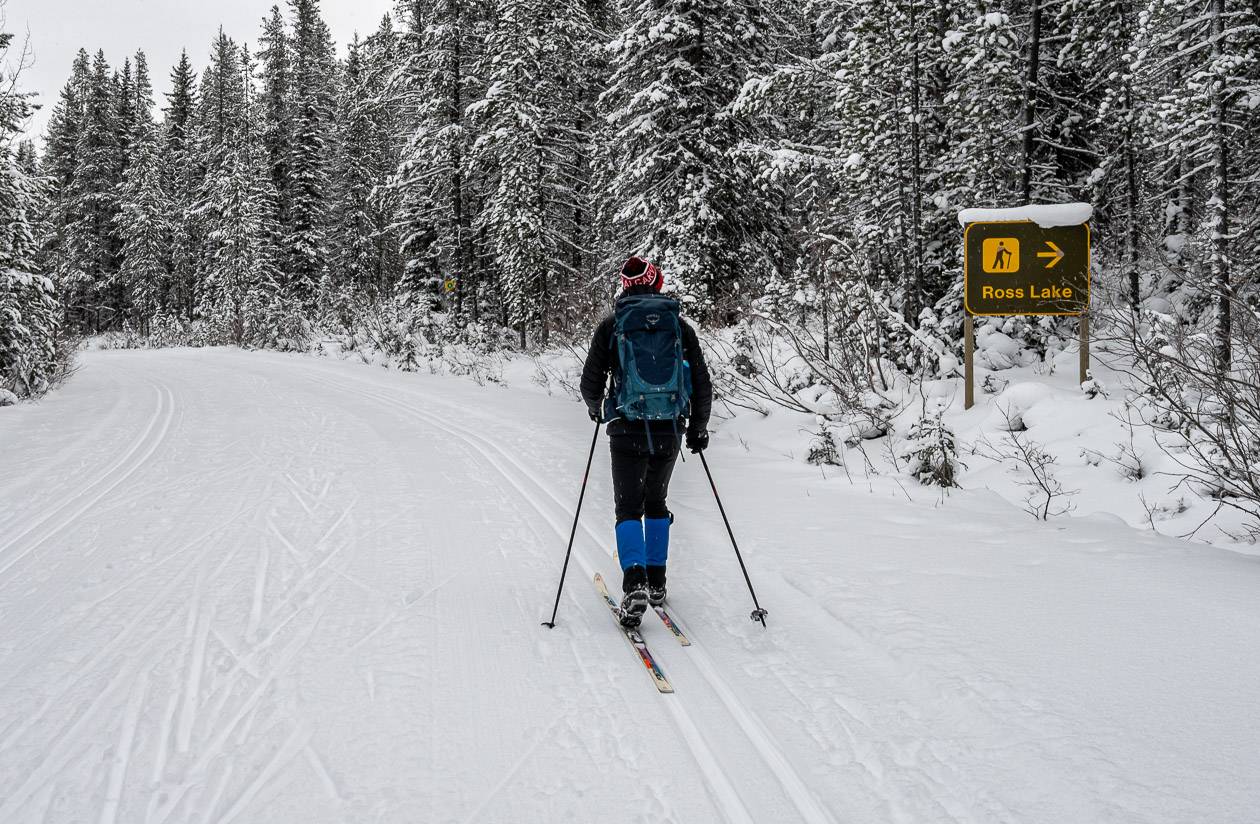

Sherbrooke Lake (you can also hike or snowshoe)
Sherbrooke Lake in a Yoho National Park winter can be accessed from the trail behind Great Divide Lodge on the Trans-Canada Highway. The trail climbs up through the trees at a moderate angle.
Around the 2 km mark it rounds the shoulder of Paget Peak and breaks out of the trees. Continue through more open terrain following the creek to Sherbrooke Lake. Stay away from avalanche terrain at the far end of Sherbrooke Lake.
This is a difficult ski but it would be fine as a winter walk or snowshoe – though in places it would be hard to avoid stepping in skiers tracks. It’s 6 km return with 180 m of elevation gain. You’ll need 3 – 4 hours to do it.

Where to stay in Yoho National Park in winter
Emerald Lake Lodgeis an ideal spot to spend a long weekend. With its fantastic location, your cabin is just steps away from stunning snowshoe and cross-country ski trails. By sometime in 2023 their hot tub should be up and running again too. Enjoy a delicious meal beside the fireplace in the lounge or pony up and book a more expensive meal in the Mount Burgess dining room.
If you don’t want to spend the money on a stay at Emerald Lake Lodge, there is the option to stay in one of the many B&B’s in Field, theCanadian Rockies Innand the Truffle Pigs Bistro & Lodge. There are also backcountry options – cue the Elizabeth Parker Hut at Lake O’Hara and Lake O’Hara Lodge – though it’s nearly impossible to get a reservation.
Hot tip: If you can’t get a reservation at Elizabeth Parker Hut you want, sign up withSchnerp. Put in your dates, the Alpine Club of Canada hut you’re interested in and you’ll be notified if there’s a cancellation. It’s free to try.
Your next option would be to stay in Lake Louise, Alberta or Golden, BC and visit Yoho National Park in winter as a day trip.
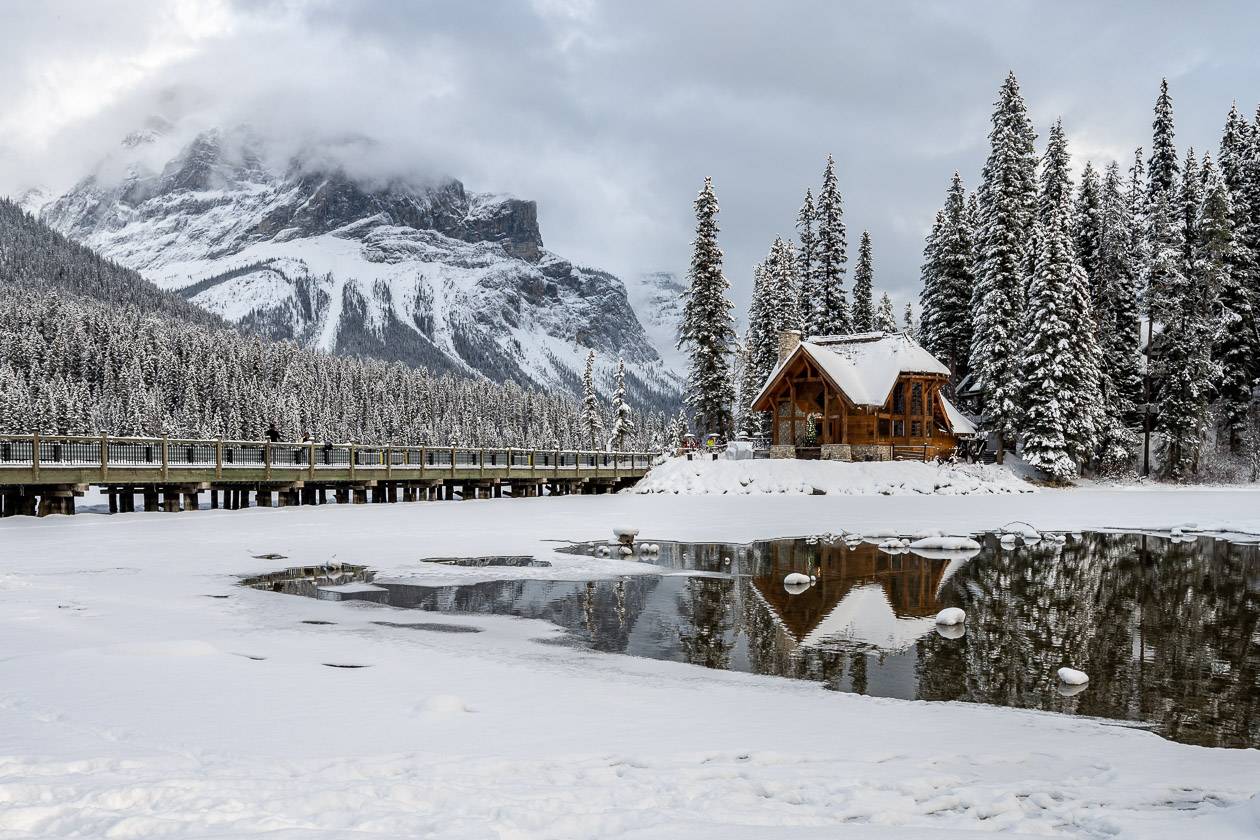

Where to eat in winter in Yoho National Park
There are only a few choices of places to eat in winter in Yoho National Park, but they’re good ones.
We’ve had excellent meals at the Truffle Pigs Bistro in Field – and they’re taking reservations now which helps. Your other option is to head up to Emerald Lake Lodge.
You can eat in the Mount Burgess Dining Room (make a reservation) or more informally in the pub or fireside in the lounge.
Helpful items to pack in Yoho National Park in winter
Be sure to pack sometoe warmersandhand warmersespecially if your visit is timed with a cold spell. You can even buyinsole warmersif your feet are prone to getting cold.
I always wear layers in the mountains. My outer layer is usually a wind-proof shell or my down jacket. More often than not I heat up and the jacket is used to stay warm at lunch. One of my favourites is Patagonia’sdown sweater with a hood. They make amale down sweatertoo.
You can rent snowshoes at Emerald Lake Lodge or in Lake Louise, but if you’re planning to do it a few times a yearsnowshoes are worth the investment. Then perhaps you’d get out even more. We have a pair made by Tubbs and one my Atlas – and both are great. They’re not to heavy and the binding is easily adjustable.
Hiking polesare also useful – whether you’re going on a walk in winter in Yoho National Park or out for a long day on snowshoes. I prefer the collapsible ones that I can put on the back of my pack.
For lunch, a bowl of hearty soup is always welcome. TheHydro Flask insulated food jarwill keep it hot.
If you’re trying to cut down on your plastic usage, I highly recommendbeeswax paperto pack sandwiches, cookies…. I’ve been using the same ones for a few years now.
Pack a fewchocolate barsas a treat because you’re going to need the energy. I highly recommend the Whittaker’s brand, especially their peanut slab.
Want to return to Yoho National Park in summer?
Yoho National Park is an extraordinary destination in summer, especially if you’re a hiker. Enjoy one of these incredible hikes from early July until the snow flies, sometime in early October. There are lots of camping options in summer too.
- Paget Lookout – Paget Peak Hike in Yoho National Park
- Hiking the Spectacular Iceline Trail near Field
- The Burgess Shale Hike in Yoho National Park
- The Lake McArthur Hike in Yoho National Park
- The Beautiful Family-friendly Emerald Lake Hike
Click on the photo to bookmark to your Pinterest boards.


